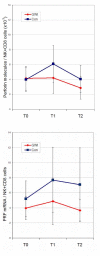Impaired immune function in Gulf War Illness
- PMID: 19265525
- PMCID: PMC2657162
- DOI: 10.1186/1755-8794-2-12
Impaired immune function in Gulf War Illness
Abstract
Background: Gulf War Illness (GWI) remains a serious health consequence for at least 11,000 veterans of the first Gulf War in the early 1990s. Our understanding of the health consequences that resulted remains inadequate, and this is of great concern with another deployment to the same theater of operations occurring now. Chronic immune cell dysfunction and activation have been demonstrated in patients with GWI, although the literature is not uniform. We exposed GWI patients and matched controls to an exercise challenge to explore differences in immune cell function measured by classic immune assays and gene expression profiling.
Methods: This pilot study enrolled 9 GWI cases identified from the Department of Veterans Affairs GWI registry, and 11 sedentary control veterans who had not been deployed to the Persian Gulf and were matched to cases by sex, body mass index (BMI) and age. We measured peripheral blood cell numbers, NK cytotoxicity, cytokines and expression levels of 20,000 genes immediately before, immediately after and 4 hours following a standard bicycle ergometer exercise challenge.
Results: A repeated-measures analysis of variance revealed statistically significant differences for three NK cell subsets and NK cytotoxicity between cases and controls (p < 0.05). Linear regression analysis correlating NK cell numbers to the gene expression profiles showed high correlation of genes associated with NK cell function, serving as a biologic validation of both the in vitro assays and the microarray platform. Intracellular perforin levels in NK and CD8 T-cells trended lower and showed a flatter profile in GWI cases than controls, as did the expression levels of the perforin gene PRF1. Genes distinguishing cases from controls were associated with the glucocorticoid signaling pathway.
Conclusion: GWI patients demonstrated impaired immune function as demonstrated by decreased NK cytotoxicity and altered gene expression associated with NK cell function. Pro-inflammatory cytokines, T-cell ratios, and dysregulated mediators of the stress response (including salivary cortisol) were also altered in GWI cases compared to control subjects. An interesting and potentially important observation was that the exercise challenge augments these differences, with the most significant effects observed immediately after the stressor, possibly implicating some block in the NK and CD8 T-cells ability to respond to "stress-mediated activation". This has positive implications for the development of laboratory diagnostic tests for this syndrome and provides a paradigm for exploration of the immuno-physiological mechanisms that are operating in GWI, and similar complex syndromes. Our results do not necessarily elucidate the cause of GWI, but they do reveal a role for immune cell dysfunction in sustaining illness.
Figures



Similar articles
-
Disentangling the effects of PTSD from Gulf War Illness in male veterans via a systems-wide analysis of immune cell, cytokine, and symptom measures.Mil Med Res. 2024 Jan 2;11(1):2. doi: 10.1186/s40779-023-00505-4. Mil Med Res. 2024. PMID: 38167090 Free PMC article.
-
Brain-Immune Interactions as the Basis of Gulf War Illness: Clinical Assessment and Deployment Profile of 1990-1991 Gulf War Veterans in the Gulf War Illness Consortium (GWIC) Multisite Case-Control Study.Brain Sci. 2021 Aug 26;11(9):1132. doi: 10.3390/brainsci11091132. Brain Sci. 2021. PMID: 34573153 Free PMC article.
-
Sex-specific differences in plasma lipid profiles are associated with Gulf War Illness.J Transl Med. 2022 Feb 5;20(1):73. doi: 10.1186/s12967-022-03272-3. J Transl Med. 2022. PMID: 35123492 Free PMC article.
-
Emerging role of glutamate in the pathophysiology and therapeutics of Gulf War illness.Life Sci. 2021 Sep 1;280:119609. doi: 10.1016/j.lfs.2021.119609. Epub 2021 May 13. Life Sci. 2021. PMID: 33991547 Review.
-
Exposing the latent phenotype of Gulf War Illness: examination of the mechanistic mediators of cognitive dysfunction.Front Immunol. 2024 Jun 11;15:1403574. doi: 10.3389/fimmu.2024.1403574. eCollection 2024. Front Immunol. 2024. PMID: 38919622 Free PMC article. Review.
Cited by
-
Adaptive Immune Responses Associated with the Central Nervous System Pathology of Gulf War Illness.Neurosci Insights. 2021 May 25;16:26331055211018458. doi: 10.1177/26331055211018458. eCollection 2021. Neurosci Insights. 2021. PMID: 34104887 Free PMC article. Review.
-
Gulf war illness-related chemicals increase CD11b/c+ monocyte infiltration into the liver and aggravate hepatic cholestasis in a rodent model.Sci Rep. 2018 Sep 3;8(1):13147. doi: 10.1038/s41598-018-31599-9. Sci Rep. 2018. PMID: 30177688 Free PMC article.
-
A Chronic Longitudinal Characterization of Neurobehavioral and Neuropathological Cognitive Impairment in a Mouse Model of Gulf War Agent Exposure.Front Integr Neurosci. 2016 Jan 12;9:71. doi: 10.3389/fnint.2015.00071. eCollection 2015. Front Integr Neurosci. 2016. PMID: 26793076 Free PMC article.
-
At the Root of 3 "Long" Diseases: Persistent Antigens Inflicting Chronic Damage on the Brain and Other Organs in Gulf War Illness, Long-COVID-19, and Chronic Fatigue Syndrome.Neurosci Insights. 2022 Jul 22;17:26331055221114817. doi: 10.1177/26331055221114817. eCollection 2022. Neurosci Insights. 2022. PMID: 35910083 Free PMC article. Review.
-
Identification of Phosphoglycerate Kinase 1 (PGK1) as a reference gene for quantitative gene expression measurements in human blood RNA.BMC Res Notes. 2011 Sep 6;4:324. doi: 10.1186/1756-0500-4-324. BMC Res Notes. 2011. PMID: 21896205 Free PMC article.
References
LinkOut - more resources
Full Text Sources
Research Materials

